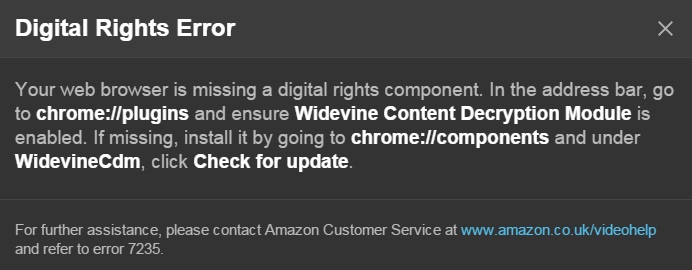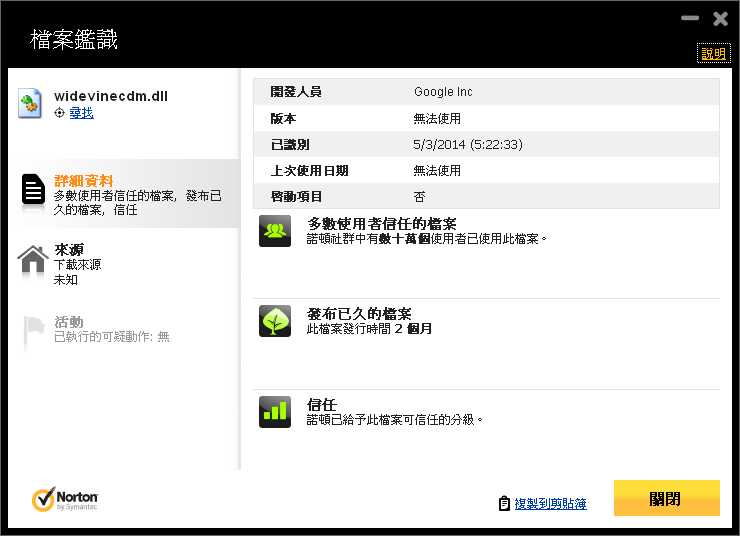Use a big collection of free cursors or upload your own. Cool Cursors for Chrome™. Tag Assistant helps to troubleshoot installation of various Google tags including Google Analytics, Google Tag Manager and more. Tag Assistant Legacy (by Google) 1,155.
How to remove WIDEVINECDM.DLL manually: STEP 1: Check all shortcuts of your browsers on your desktop, taskbar and in the Start menu. Right click on your shortcut and change it's properties. You can see WIDEVINECDM.DLL at the end of shortcut target (command line). Remove it and save changes. Replied on May 4, 2020. There is a problem with the Widevine Content Decryption Module component in Edge. It will not hold the update to version 4.10.1610.0. When the update button is clicked it updates to that latest version, but when Edge is cycled out and back in again the version reverts back to 4.10.1582.1. 5 Methode 2: Need to change Change Chrome Permissions For WidevineCdm. 6 Method 3: Deleting plugin folder and updating it. 7 Method 4: Temporarily disable your antivirus and Firewall to update the widevine content decryption module. 8 Methode 5: Perform a fresh Google Chrome Installation.
Widevine is a proprietary digital rights management (DRM) technology from Google used by the Google Chrome and Firefox web browsers (and some derivatives), Android MediaDRM, Android TV, and other consumer electronics devices. Widevine technology supports various encryption schemes and hardware security to restrict consumer access to distributed video content according to rules defined by content owners. Widevine mainly provides a Content Decryption Module (CDM) as a client to Google Chrome and other browsers and devices. Widevine is free to use by content providers and as such does not charge any fees for license generation or device integration.[1][2]
Security levels[edit]
The three Widevine security levels are:[3][4]
- L1―no resolution or HDR restriction; highest level of protection. Both cryptography and media processing operations occur in a trusted execution environment (TEE).
- L2―(typically) 540p resolution limit. Only cryptography operations are executed in a TEE, not media processing.
- L3―(typically) 480p resolution limit. Software-based DRM only.
Usage[edit]
Widevine DRM is used with the Chromium-based proprietary web browsers and on Android.[5] It supports MPEG-DASH and HLS.[6]Google Chrome and Chrome OS make use of Encrypted Media Extensions and Media Source Extensions with Widevine, where it is used to decrypt content.[7] Over thirty chipsets, six major desktop and mobile operating systems, and Google properties such as Chromecast and Android TV have adopted Widevine.[8]
Companies including Amazon Prime Video, BBC, Hulu, Netflix, Spotify and Disney+ use Widevine DRM to manage the distribution of premium content.[9][10]
It is also used by Firefox since v47, released in 2016,[11] enabled by default on Microsoft Windows and optionally on Linux; it can be disabled and uninstalled in the browser settings.[12] Prior to that, Mozilla used Adobe's Primetime DRM library for some versions.[13]
Users[edit]
Open-source projects[edit]
Widevinecdm Chrome Update
- Shaka Player – Google-developed open-source HTML5 web-based player available on GitHub.[14]
- Shaka Packager – Google-developed open-source content packaging solution available on GitHub. The packager supports MPEG-DASH and HLS for VOD or linear based content.[15]
- Shaka Streamer – Google-developed simple configuration-file-based tool for preparing streaming media content.[16]
- Electron software framework – Widevine partnered with castLabs to integrate the Widevine client into the Electron framework for use with desktop application development.[17] The integration, however, still requires anyone who wants to distribute/use it in their application to sign a license agreement with Google.[18]
- Kodi – starting from version 18, the add-on InputStream Helper installs Widevine automatically on supported platforms for DRM playback.[19]
Criticism[edit]
In 2019, a developer tried to bundle Widevine in an Electron/Chromium-based application for video playing and did not get any response from Google after asking for a license agreement, effectively blocking DRM usage in the project.[20][21] He later got the reply:

I'm sorry but we're not supporting an open source solution like this

The same happened to other Electron projects.[22]

Developers of a competing browser to Chrome, Brave (a fork of Chromium itself), also had issues during their integration due to Netflix authentication on the reliability of the Brave browser.[23]
History[edit]
Widevine Technologies was a vendor of digital rights management software. One of its early technologies included a software system that replaced smart cards that eliminated the cost and logistical complexity of the card's distribution and introduced the abilities to process more sophisticated rights.[24] It was purchased by Google in 2010.[25]
References[edit]
- ^'Widevine Media Optimizer | Encoding.com'. Encoding.com. Retrieved 2018-08-06.
- ^'Widevine digital rights management explained'. Android Authority. 2017-12-11. Retrieved 2018-08-06.
- ^'How to check if your Android device supports Widevine DRM'. xda-developers. 2021-03-27. Retrieved 2021-05-05.
- ^'Getting Started - Widevine DRM on Devices'(PDF). Archived(PDF) from the original on 2019-05-04.
- ^Triggs, Robert (2017-12-11). 'Widevine digital rights management explained'. androidauthority.com. Retrieved 2018-01-11.
- ^Semba, Taku (2018-05-31). 'HLS with Widevine for Android'. Taku Semba. Retrieved 2018-08-06.
- ^'The Complete Guide to Widevine'. encoding.com. Retrieved 2018-01-11.
- ^'Supported Platforms'. Widevine. Archived from the original on 2013-09-13. Retrieved 2018-01-11.
nearly 4 billion devices
- ^Langner, Christoph (2016-05-05). 'Amazon Prime Video mit Kodi und dem Raspberry Pi (jetzt mit Input Stream und Widevine)' (in German). linuxundich.de. Retrieved 2018-01-11.
- ^'BBC deploys BuyDRM to secure premium digital content'. Digital TV News. Retrieved 2018-08-06.
- ^Mozilla. 'Mozilla To Test Widevine CDM in Firefox Nightly To Facilitate Video Watching Online'. Future Releases. Retrieved 2019-05-31.
- ^'Watch DRM content on Firefox | Firefox Help'. support.mozilla.org. Retrieved 2019-05-31.
- ^'Firefox 52: Mozilla disables Adobe Primetime CDM Plugin'. Techdows. Retrieved 2021-05-31.
- ^JavaScript player library / DASH & HLS client / MSE-EME player: google/shaka-player, Google, 2019-03-01, retrieved 2019-03-01.
- ^A media packaging and development framework for VOD and Live DASH and HLS applications, supporting Common Encryption for Widevine and other DRM Systems: google/shaka-packager, Google, 2019-03-01, retrieved 2019-03-01.
- ^A simple config-file based approach to preparing streaming media, based on FFmpeg and Shaka Packager: google/shaka-streamer, Google, 2019-11-08, retrieved 2019-11-12.
- ^'castlabs/electron-releases: castLabs Electron for Content Security', GitHub, castLabs GmbH, 2019-02-28, retrieved 2019-03-01.
- ^Maddock, Samuel. 'Support Widevine CDM · Issue #85 · samuelmaddock/metastream'. GitHub. Retrieved 2019-07-25.
- ^Matt Huisman (2018-05-28). 'Kodi Widevine Support'.
- ^Doctorow, Cory. 'After years of insisting that DRM in HTML wouldn't block open source implementations, Google says it won't support open source implementations'. Boing Boing. Retrieved 2019-07-25.
- ^Maddock, Samuel (2019-04-02). 'I tried creating a web browser, and Google blocked me'. Samuel Maddock’s Blog. Retrieved 14 May 2021.
- ^'Netflix isn't working even with Widevine correctly loaded. · Issue #12427 · electron/electron'. GitHub. Retrieved 2019-07-25.
- ^Bondy, Brian R. (2017-08-21). 'Netflix Streaming Error · Issue #10449 · brave/browser-laptop'. GitHub. Retrieved 2019-07-25.
- ^Gerbarg, Darcy (2008). Television Goes Digital. New York: Springer Science+Business Media. pp. 214. ISBN9780387799773.
- ^Watson, James; Hill, Anne (2015). Dictionary of Media and Communication Studies, 9th edition. New York: Bloomsbury Publishing USA. p. 119. ISBN9781628921489.
External links[edit]
- Official website